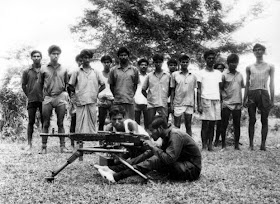 Following Suhrawardy's death in 1963, Mujib came to the top position of Awami League, the largest political Party in Pakistan.Ther party had dropped the word "Muslim" to show shift towards secularism and a broader appeal to non-muslim communities. Mujib was one of the key leaders to rally opposition to President Ayub Khan's Basic Democracy, the martial law and the one unit schemewhich centralised powers and and merged the provinces.Working with other political parties, he supported opposition candidate Fatima Jinnah against Ayub in the election of 1964. Mujib was arrested two weeks before the election, charged with sedition and jailed for one year.
Following Suhrawardy's death in 1963, Mujib came to the top position of Awami League, the largest political Party in Pakistan.Ther party had dropped the word "Muslim" to show shift towards secularism and a broader appeal to non-muslim communities. Mujib was one of the key leaders to rally opposition to President Ayub Khan's Basic Democracy, the martial law and the one unit schemewhich centralised powers and and merged the provinces.Working with other political parties, he supported opposition candidate Fatima Jinnah against Ayub in the election of 1964. Mujib was arrested two weeks before the election, charged with sedition and jailed for one year.In these years there was rising discontent in east Pakistan over the atrcities committed by the military against Bengalis and the neglect of the issues and needs of the East Pakistan by the ruling regime. Despite forming a majority of the population , the Bengalis were poorly represented in Pakistan's civil sevices, police and military. There also conflict of the allocation of revenues and taxation.Unrest over continuing denial of democrcy spread across Pakistan and Mujib intensified hisopposition to the disbandment of provinces . In 1966, Mujib proclaimed a 6-pt plan titled our charter of survival at a national conference of opposition poltical parties at Lahore, in which he demanded self-govrnmentand cosiderable political, economic, and defence autonomy for East Pakistan federation with a week central Govt.Mujib's points catalysed public support ac ross East Pakistan, launching what some historians have termed the 6-pt movement - recognized as the definite gambit for autonomy and rights of Bengalis in Pakistan.
Mujib was arrested along with 34 Bengali Military officers and was put in the charge of Agartala Conspiracy Case. Mujib then extended his 6-pt plan to 11-pt one.
Many of his supporters called him as "Bangabandhu".













.jpg)
.jpg)
.jpg)
.jpg)
.jpg)
.jpg)
.jpg)
.jpg)
.jpg)
.jpg)
 Wary of the growing invovement of India , the Pakistan Air force (PAF) launched a premptive strike on india. The attack was modelled on the Israeli Air Force's Operation Focus during the six day war.
Wary of the growing invovement of India , the Pakistan Air force (PAF) launched a premptive strike on india. The attack was modelled on the Israeli Air Force's Operation Focus during the six day war.


.jpg)




 Mukti Bahini
Mukti Bahini



.jpg)
.jpg)










